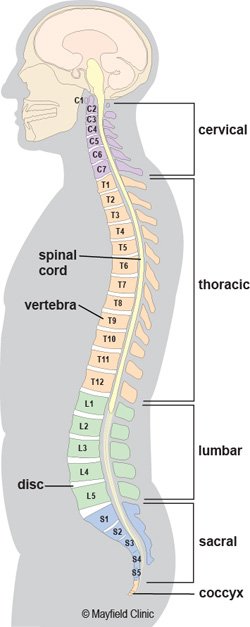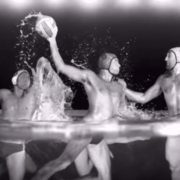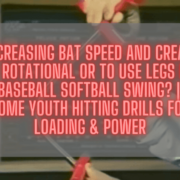Does baseball and softball hitting power come from loading the hips and rotating them before the hands? Discover how to properly AND safely swing the bat harder, hit the ball better, and farther hitting drills.
How “Loading & Exploding The Hips” Can Be VERY Dangerous To The Lower Back…
We’ll get to the above video, but first let me be clear…
I’m not saying the pelvis doesn’t play a role in the swing, because it does. However, I feel this spot reserved in the swing’s sequence of movements is hyper-focused on by a majority of hitting gurus. More and more research is saying extreme “hip thrust” or “loading and exploding the hips” can be VERY damaging to the lower back over time. You’ll see why in a moment, but for now please note that in this podcast episode, former USA Men’s Gymnastics Coach Sommers says the lower back portion of the spine isn’t made for a high degrees of rotation, but the T-Spine is.
Another thing I want to clear up, we don’t teach a 100% pure rotational mechanics here. We teach a blend of linear-rotational. Please CLICK HERE to read our thoughts on this.
In this post, we’ll cover:
- How the spine stacks up (quick anatomy lesson),
- Does consistent power come from the ground? And,
- Teaching hitters a safer more effective swing.
Let’s get started…
SCIENCE-BASED TRAINING:
Improve your hitting strategy dramatically by applying human movement principles.
Learn not only how and what to train but also the science behind the methods.
How the Spine Stacks Up

Photo courtesy: MayfieldClinic.com
Here’s a quick anatomy lesson of the spine:
- Cervical – the vertebrae in your neck, consists of 7 vertebrae, are allowed to flex, extend, and rotate,
- Thoracic – the vertebrae in the middle of spine including shoulders, consists of 12 vertebrae, which are also allowed to flex, extend, and rotate, and
- Lumbar – the vertebrae in lower back, consist of 5 vertebrae, and are allowed to flex and extend ONLY.
- Sacral & Coccyx – there are 5 fused vertebrae here, and the Coccyx is sometimes referred to as the “tail” bone.
Did you catch that about the Lumbar? It’s important, so it bares repeating…the vertebrae in the lower back IS NOT built to rotate! Right now, you may be thinking: “Wait a minute, how’s that?! I’ve seen millions of swings, and the hitter’s pelvis (and lower back) are rotating!!”
According to Charlie Weingroff, DPT, CSCS, a physical therapist, a trainer in New York City, and is pretty high up on the human performance food chain, says this:
“Only your thoracic spine (which consists of the 12 vertebrae in your upper and middle back) is designed to rotate significantly — about 40 degrees in each direction, according to Weingroff — when under compression. The lumbar spine (lower back) should rotate no more than about 12 degrees.”
Some movement experts (like Thomas Myers, author of the book Anatomy Trains), says the lower back can rotate no more than 7-degrees. So according to the experts, 7 to 12-degrees is a good rotational range for the Lumbar section of the spine. That’s NOTHING compared to the 40-degrees of rotation – in each direction – of the middle and upper back section of the spine (which includes shoulders).
So what’s happening then? You see, since the lower back vertebrae are not designed to rotate, it’s the surrounding muscles that are rotating a fixed object (non-rotating Lumbar), and is why you do see rotation. The T-Spine vertebrae are built to rotate (again, this includes the shoulders), hence is why hitting coaches should put their rotational focus there and NOT the hips, pelvis, or low back.
Is rotating back hip through the zone necessary for power? Not in the way most coaches think. Consider this quote from Physicist, Electrical Engineer, and author of the book The Spinal Engine, Dr. Serge Gracovetsky:
“The axial rotation of the spine cannot happen unless the spine is flexed by the right amount on the correct side. Coaching an athlete to throw without a proper spinal position is an invitation to severe torsional injuries.”
Dr. Gracovetsky is referring to this “flex” as a side bend with the shoulders. The point is, USE THE SHOULDERS to accomplish rotational power. Warning for coaches: if you shrug this information off because of ego or pride, and continue to teach pelvis, hip, or lower back dominant twisting swings, then you’re wearing holes in the low backs of your hitters. Be careful because the link is there, and one can be held liable.
Don’t worry, I’ll show those coaches doing this unknowingly a safer way, at the end of this post…
Does Consistent Power Come from the Ground?

Water Polo throw photo courtesy: YouTube Egy image from video
You may be thinking, but consistent power comes from the ground…the pelvis is the first to interact with Gravitational Forces, and that’s why you teach “hip thrust”. I agree with Ted Williams that the ‘Hips Lead the Way’, but they don’t contribute as much to consistent power as most think. I know this may sound earth shattering for some, so please stay with me here.
CLICK the following link to a post I did titled, “The Swing DOES NOT Start From The Ground & Move Up?”
This brings me to the water polo throw video above…
Let me ask you a question, what do you think the “fastest throw in Water Polo” is? Doing a Google search using those keywords brings up the following statement:
“The overhand shot from a Croatian senior men’s national team player is recognized as the fastest shot in the world at 60 MPH (96.5 KPH). The overhand shot is the standard throwing motion in water polo. It is the same arm motion as a pitcher uses in baseball.”
So, let’s think about this. In water, there are little to no Gravitational Forces, and the best human floating in water, can throw a volleyball-sized ball 60-mph? What do you think the speed would be if this person was floating in water and threw a baseball-sized ball instead? 75-mph? 80-mph? 90-mph? Okay, so let’s say this top-of-the-food-chain water polo player throws a baseball floating in water 80-mph. You’re telling me a top-of-the-food-chain pitcher in the Big Leagues, throwing down a mound, can only throw 20-mph more (assuming 100-mph) than someone throwing the same ball floating in water?!
I dunno, but this begs the question, does the pelvis (and lower Lumbar), OR the shoulders (and T-Spine) contribute the most to pitching velocity AND Ball Exit Speeds?
If you need to see more examples about this, then CLICK HERE for a swing experiment titled, “How Much Ball Exit Speed Does Pelvis Contribute To A High Level Swing?”
Consider this Tweet from one of my readers…
How fast before “squashing bug with the knee” is a thing? @hitperformlab https://t.co/IOso6gZ4yV
— This Is The Way (@Eaglzphan22) August 22, 2018
And I added the following comment…
Buahaha! I love that. Slipping front foot, no extension at front knee, and "hammering bug" with back knee. Result? A dinger! A lot of unhappy gravitational force peeps out there ? @backspintee
— Joey Myers (@hitperformlab) August 22, 2018
So what role do I think the pelvis and low back play in the swing, if not power? Directional force. Allows the hitter’s swing to convert Centripetal into Centrifugal Force. In a nutshell, the hitter’s “belt buckle” must point in the direction of the batted ball.
So what’s the answer?
Teaching Hitters a Safer more Effective Swing
Here are some resources to get you started, outside of the ones already mentioned:
- The Swing Does NOT Start From The Ground & Move Up?
- Baseball Hitting Drills Off Tee: Hitting May Be Dangerous To Your Spine [Zepp Swing Experiment]
- Why I Teach Hitters To ‘Show Numbers’ (And Maybe You Should Too)
- Homer Bush Interview: How To Turn A Pitcher’s Best Weapon Against Them
- Matt Nokes Reveals Ways To Dramatically Increase Power
- How To Quickly & Easily Get Your Hitters On-Time With The “Snap Drill”
Coaches, PLEASE get educated. Don’t let ego or pride get in the way of helping hitters swing safe. Like Tony Robbins says,
“If you aren’t growing, then you’re dying.”



